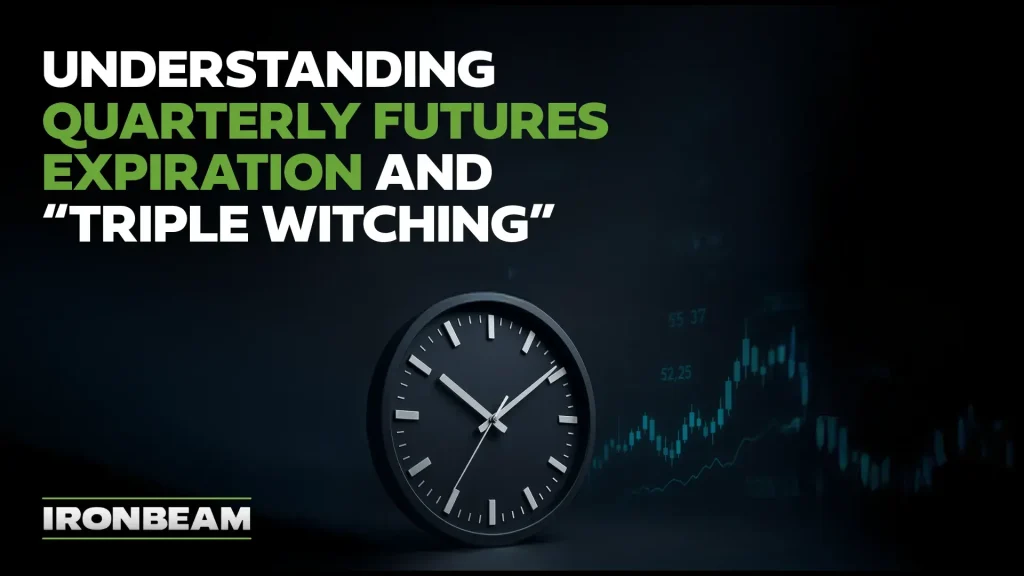Understanding Quarterly Futures Expiration and Triple Witching

Four times a year the futures markets experience quarterly expiration. The next one is on Friday, September 19, 2025. On these days stock index futures, stock index options, and stock options all expire at once, which traders call triple witching.
Triple witching is not mysterious, but it can create unusual trading conditions. Large institutional players roll or close positions to avoid delivery or to reset exposure for the next quarter. This activity often drives a surge in volume and sudden bursts of volatility, especially during the final hour of trading known as the witching hour.
Which Futures Contracts Are Involved
The September triple witching affects nearly all equity index futures and their options. The main U.S. contracts include:
- E-mini S&P 500 (ES) and Micro E-mini S&P 500 (MES)
- E-mini Nasdaq-100 (NQ) and Micro E-mini Nasdaq-100 (MNQ)
- E-mini Dow Jones (YM) and Micro E-mini Dow Jones (MYM)
- E-mini Russell 2000 (RTY) and Micro E-mini Russell 2000 (M2K)
- Standard-size versions of the S&P 500 and other index futures where open interest remains
- Options on all of the above index futures
These contracts all settle on the same third Friday of September. Many traders also roll related volatility products, ETF options, and sector index futures that track the same indexes.
Why It Matters to Retail Futures Traders
- Higher Volume and Volatility
Liquidity spikes as funds and market makers adjust hedges and rebalance portfolios. This can lead to sharp intraday price swings, especially in the contracts listed above. - Price Distortions
Large roll orders can push prices temporarily away from fair value. Spreads between futures and the underlying cash index may widen. - Execution Challenges
Fast markets increase the risk of slippage. Limit orders can be filled far from expectations if the order book thins out suddenly.
Practical Tips for Navigating Triple Witching
Know the Calendar
Mark the third Friday of March, June, September, and December. Plan your trade entries and exits with those dates in mind.
Reduce Position Size
If you normally trade multiple contracts, consider scaling back. Smaller size helps you stay nimble when the order book gets jumpy.
Use Limit Orders
Market orders during volatile periods can lead to unexpected fills. Limit orders provide more control over execution price.
Watch the Final Hour
Many institutional rolls happen late in the session. If you are not seeking to trade that volatility, step aside or tighten stops well before the close.
Consider Spreads or Rolls Early
If you need to roll a position into the next quarter, doing so a few days ahead of expiration can reduce the risk of getting caught in crowded end-of-day flows.
Key Takeaway
Triple witching is a scheduled event that rewards preparation. By understanding which contracts are involved and how expiration affects liquidity and price action, retail traders can decide whether to participate in the volatility or sit it out.
With Ironbeam
Ironbeam gives traders direct access to the contracts most active during triple witching. Through Ironbeam’s platform you can trade E-mini and Micro E-mini index futures such as ES, NQ, RTY, and YM with competitive day-trade margins, real-time Level 2 market depth, and chart trading across desktop, web, and mobile.
The platform’s depth-of-market tools and customizable alerts help traders monitor volume surges and manage orders during the volatile expiration session. Educational resources and detailed contract specifications for each index product are available in the Ironbeam client portal so you can plan rolls or spreads ahead of the September 19 expiration.
Start Trading Smarter.
Open your Ironbeam futures account and access the markets with confidence – on your terms.
About the Author
Brent Murphy is a Series 3–licensed broker and Business Development Specialist at Ironbeam. For the past five years he has partnered with traders, introducing brokers, funds, CPOs, and CTAs, delivering technology, trading, and clearing solutions to help clients thrive in the futures markets.
Contact Brent at [email protected]
RISK DISCLAIMER: There is a substantial risk of loss in trading commodity futures and options. Past performance is not necessarily indicative of future results. Only risk capital should be used. Losses from commodity investments may be greater than the initial investment(s). Commodity trading is not appropriate for all investors, and a commodity investment must be evaluated in light of the potential for risk of loss as well as the possibility of profit.
